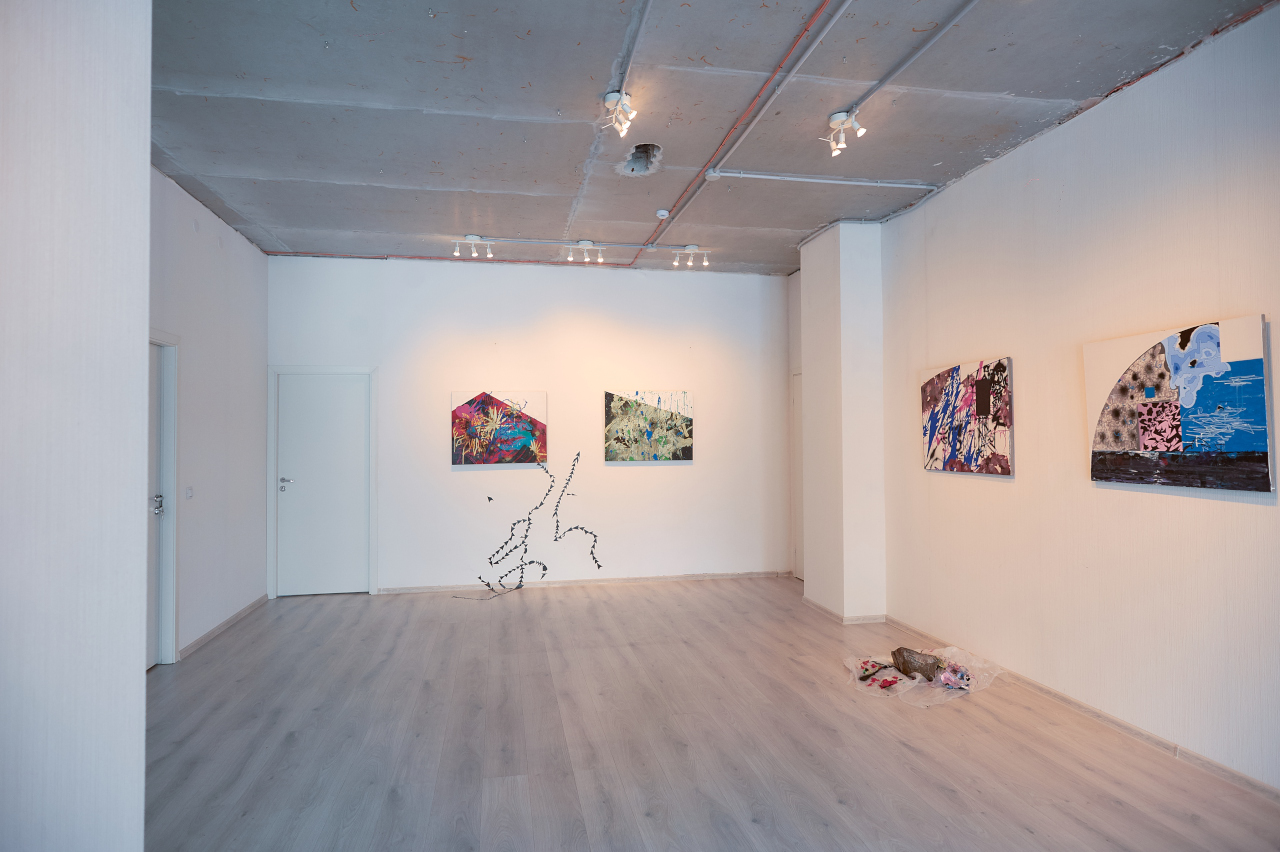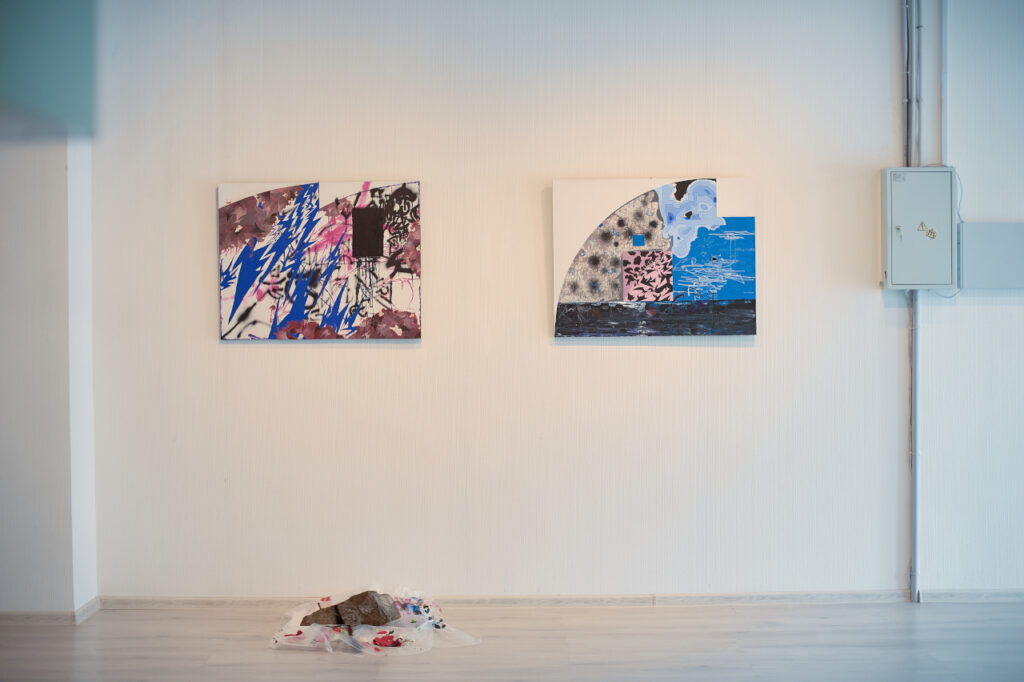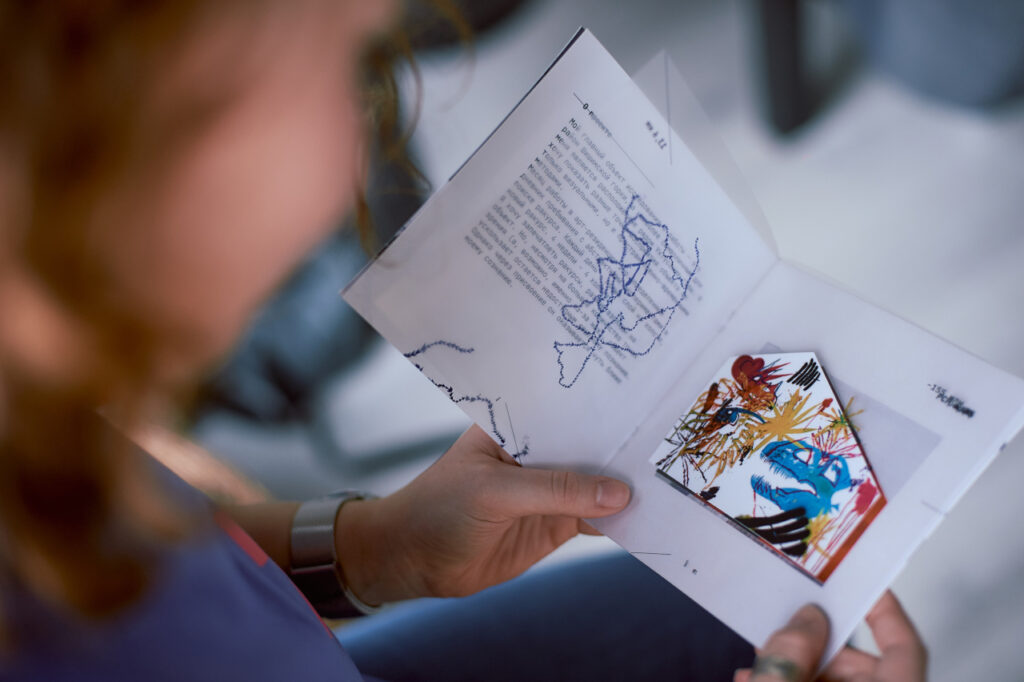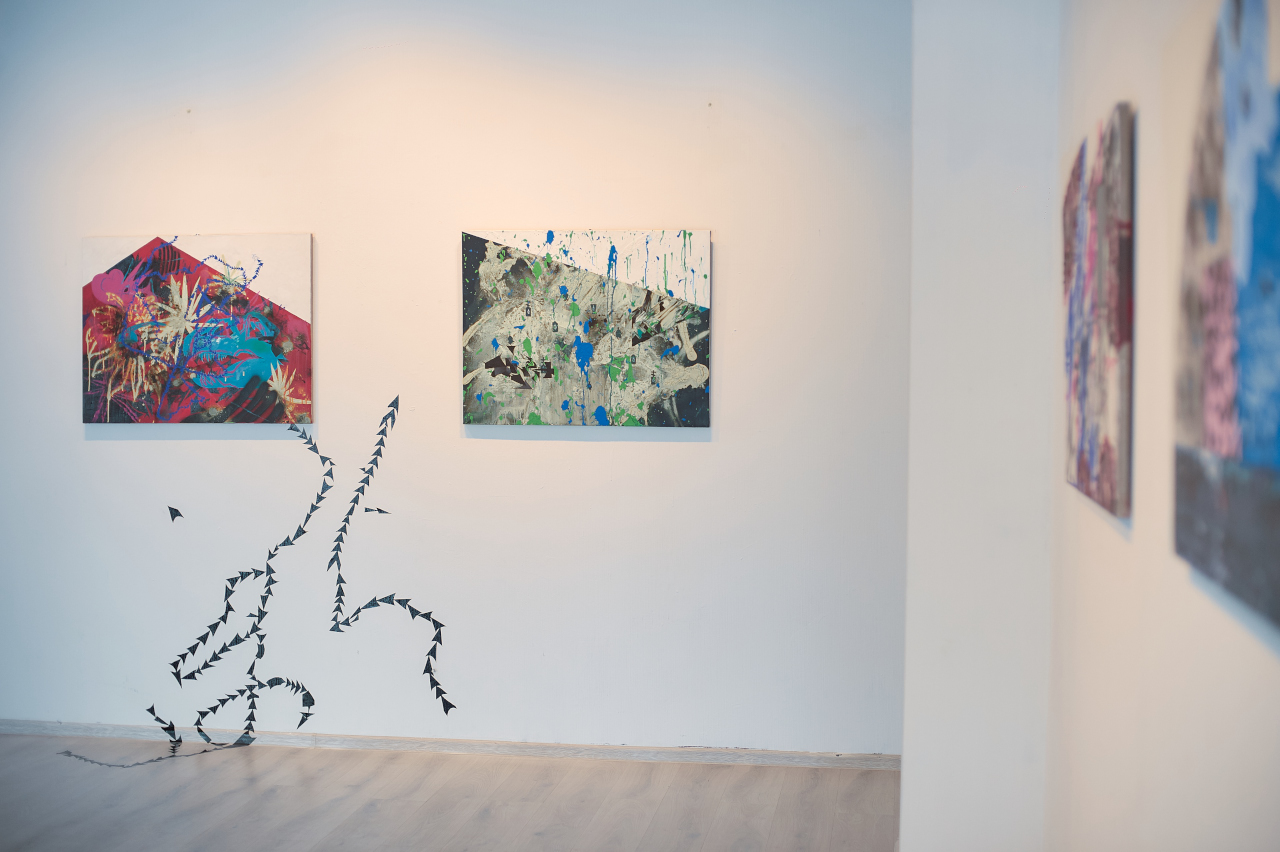A diary 1111
A material object is typically perceived from a single perspective, and even when viewed from different angles, our minds often maintain the same perception of it, as we tend to see things in a sensual and visual manner. However, in reality, the object itself is abstract, lacking clear boundaries, and can appear entirely different from various angles, almost losing its materiality.
In the “Diary 1111” project, the primary focus of artistic exploration is the Uktus mountains, situated in close proximity to the Shishim hill area. The objective was to showcase the object’s diverse perspectives of perception not only through visual means but also through spatial-temporal methods.
The month-long stay at the art residence is presented as a personal diary, documenting abstract experiments undertaken in the quest for interpretations. Each day is represented by a new layer on the canvas, capturing a fresh angle of view. Over the course of four weeks, four canvases were created, each offering a distinct perspective.
Shishim Hill Artist-in-resident program
Curator Zhenia Chaika
2020
Yekaterinburg, Russia




In this project, I examine the object from different angles, challenge the boundaries of the perception unattainability. The time I spend, and the meanings that open up, I record in a kind of research diary. I do not strive to reach the unattainable, the truth, but I state the value of the moment, the process.
I want to capture the angles, different views on the object. Despite a large number of viewpoints (and, perhaps, precisely due to them), the object escapes, remains inaccessible to experimental cognition. However, through appropriation, it becomes is a little closer to my mind. “Layer by layer, I simultaneously get to the core of the object and irreversibly move away from it.
Layers
385. The absolute height of the Uktus mountains is 385 meters. On canvas, this number is transformed into to an absolute quantitative value – 385 strokes: from a blank canvas to the completed first layer.
μορφή. Morfi – form. Form is acquired through its loss. The wood turns into paper, and the resin into turpentine. Physical bodies in search of form are represented by paper volumes: they help to interpret forest cover. The image of these evolving forms returns us with an endless loop to the subject of the research – the Uktus mountains.
PCP 6,35. Rifles PCP. Caliber 6.35. 2 girls. Picnic. 10 pm. 2 shots. The bullet trajectory is an abstract line drawn in black on red. This is a story of the tragic death of two students in the Uktus mountains.
-155 million. 155 million years ago, continents formed, plates moved, mountains appeared. The Uktus Mountains formed in the Jurassic period, they are peers of dinosaurs. Therefore, their depiction -skulls and ribs – make up the next layer.
13,6 km. 13,6 kilometers – the length of the route that the artist walked in the Uktus mountains. A random path, the only purpose of which is to feel engagement in the object of study. Slopes and descents, forest, deep snow – this is a digital footprint within the local ecosystem.
Yellow snow. The layer of physical interaction between the space and the canvas, it highlights a constant human presence. In winter, the mountain is covered with snow, people can paint the snow yellow. Snow soaked in urine was put on the canvas, melted and left its mark.
Green stone. Layer-reference to geology. The Uktus mountains are composed of massive crystalline gabbro rocks, peridotites and dunites. Gabbro is often used for tombstones, peridotites and dunits are put out to maintain heat in baths and saunas. Conventional signs of these functions – crosses and whisks – make up the painting layer.
Blue splash. Layer of random action: paint dropped from a mountain falls onto the canvas. Thus, one can feel the height, movement, and energy.
Colorless composition. The minerals that form a mountain can be seen through a microscope. Enlarged in hundreds of times they turn into an intricate, but colorless ornament, hidden structures. One of these structures is transferred to the canvas.
Black vandalism. Geological perspective of time returns the artist to the beginning of his career – to graffiti. So, the final layer of the canvas is a graffiti tag, which encompasses reflections upon the start of the path and the wall paintings in the Uktus.
Sound. To understand how the object of study sounds, the artist recorded sounds from the area on a voice recorder. After digitizing them, he saw the waves pattern and got a modern sound. These manipulations with sound became the basis for a sensual visual image of the area’s sound.
Intuitivism. A layer that turns to Theosophy and Esotericism. Mountains often became and are becoming the habitat of spiritual mentors. The works of Nicholas Roerich are widely known, but there are other “gurus” who urge to practice “automatic writing” or “automatic drawing.” An example of such a technique is expressed in this layer.
Penetration. On one of the hills in the Uktus Mountains there is a Slavic Sanctuary of Perun God. It is an active sanctuary, in which Old Slavonic ceremonies are held in honor of the god Perun by a certain community reviving the customs of the Slavic priesthood. Perun is the Slavic god of thunder and lightning. As a sign of breaking into the secret sanctuary, lightning and ultramarine as the color of Perun appear on the canvas.
Corrosion. The rust texture is recreated on the canvas, which brings us back to the origins of the urban history in the Uktus mountains, to the times when the iron plant gave rise to Yekaterinburg.
Unavailability. The final layer speaks about the impossibility of exploring the object. A black mass arises on the canvas – again and again testifying to the fundamental inexhaustibility of the process of understanding an object.
Precipitation. In one way or another, an attempt to explore a mountain appeals to the natural object. The little piece of nature that remains in the urban life is the weather forecast. In the next layer, the artist transfers a heatmap of local precipitation to the canvas, which is taken by a meteorological radar on the day the canvas was created.
Antipode. Every place on Earth has an opposite point. The coordinates of the point that is diametrically opposite to the Shishim hill are 56°46’11.8″S 119°20’56.9″W. It is located in the South Pacific. The marine relief is conventionally depicted on canvas.
Post-perception. The artist paints mountains or how he expresses them through his points of perception. The viewer passing by the residence sees this process through his prism of perception, thereby imposing his understanding on the object of study. The artist imposes the drawing process and the process of the viewer’s perception on the paint, later the viewer returns to his process, but with a different interpretation.
Dust. Dust and industrial waste that lands on the walls, on the leaves of trees, which filter our air, make up another layer of perceiving the highlands and another layer on the canvas.
Magic mountain. Metaphorical possession of the object in study, the desire to conquer it, its fetishization brings us closer to comparing the process of cognition with sex. Pose 34 – The Magic Mountain.
